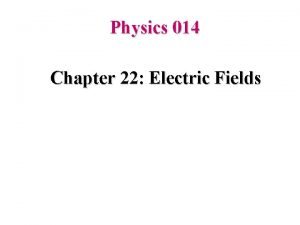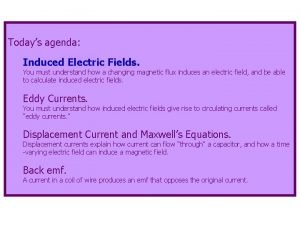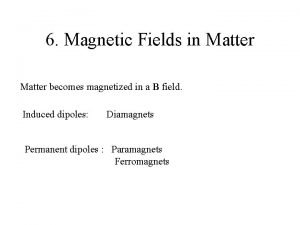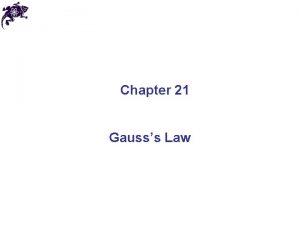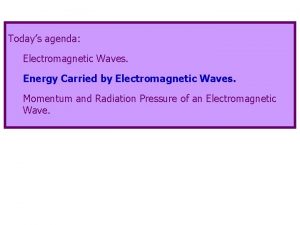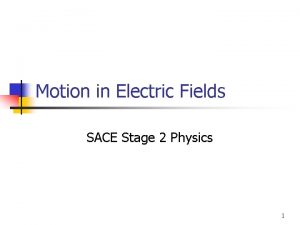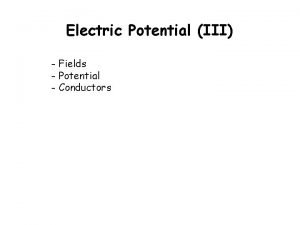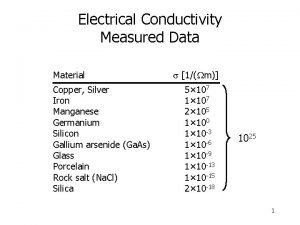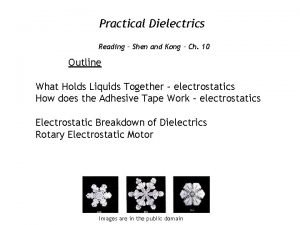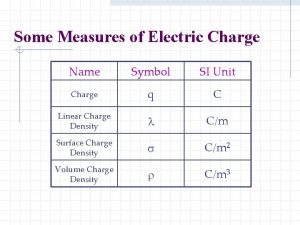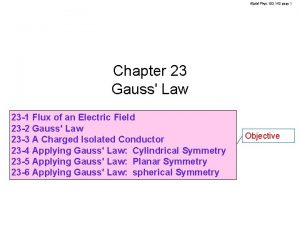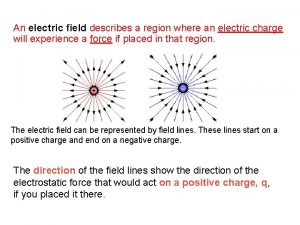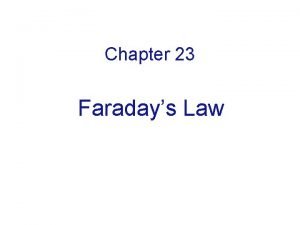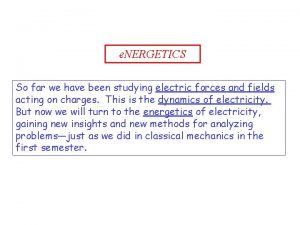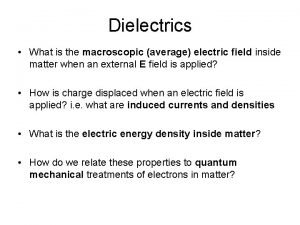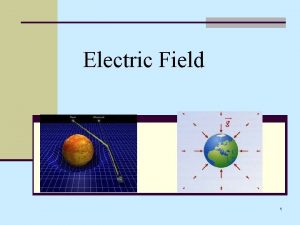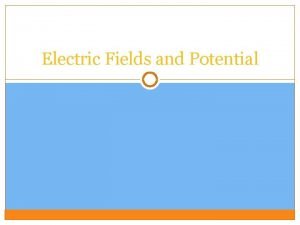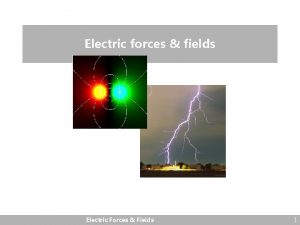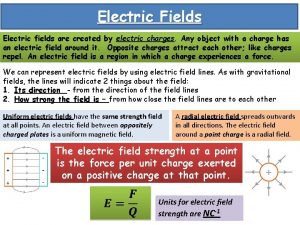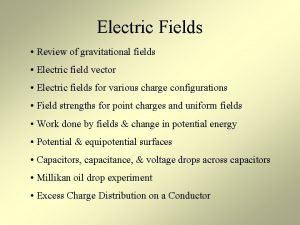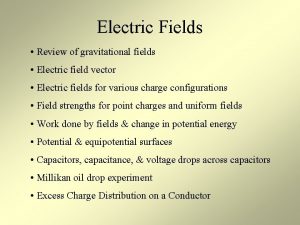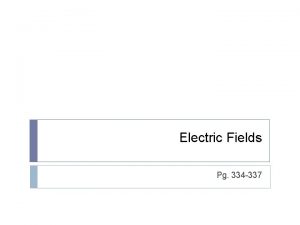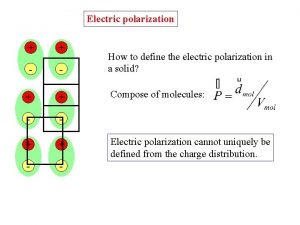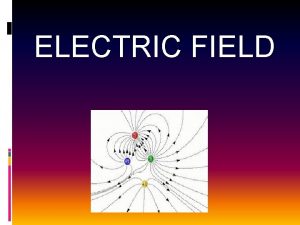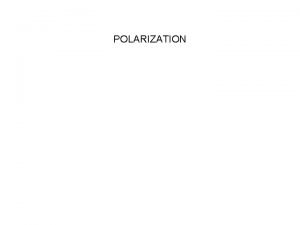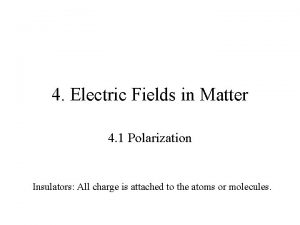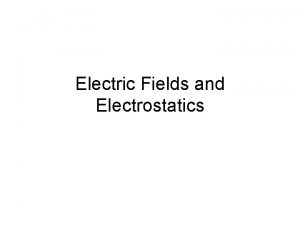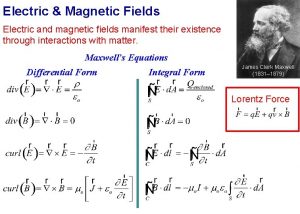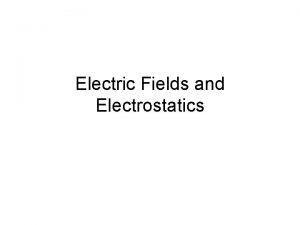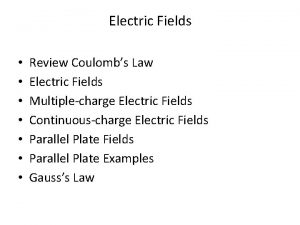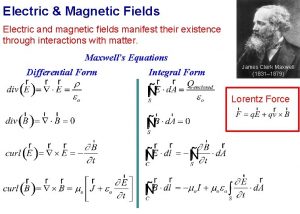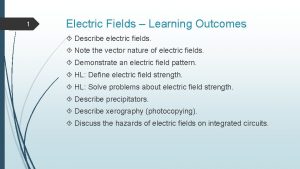Electric Fields in Matter v Polarization v Field






















































- Slides: 54

Electric Fields in Matter v Polarization v Field of a polarized object v Electric displacement v Linear dielectrics

Conductors Matter Insulators/Dielectrics All charges are attached to specific atoms/molecules and can only have a restricted motion WITHIN the atom/molecule.

When a neutral atom is placed in an external electric field (E): … positively charged core (nucleus) is pushed along E; … centre of the negatively charged cloud is pushed in the opposite direction of E; • If E is large enough ► the atom gets pulled apart completely => the atom gets IONIZED

• For less extreme fields ► an equilibrium is established ……. the attraction between the nucleus and the electrons AND ……. the repulsion between them caused by E => the atom gets POLARIZED

Induced Dipole Moment: (pointing along E) Atomic Polarizability

To calculate : (in a simplified model) The model: an atom consists of a point charge (+q) surrounded by a uniformly charged spherical cloud of charge (-q). -q +q a +q -q d E At equilibrium, ( produced by the negative charge

At distance d from centre, (where v is the volume of the

Prob. 4. 4: A point charge q is situated a large distance r from a neutral atom of polarizability . Find the force of attraction between them. Force on q :

Alignment of Polar Molecules: Polar molecules: molecules having permanent dipole moment Ø when put in a uniform external field:

Alignment of Polar Molecules: Ø when put in a non-uniform external field: +q F+ d F- -q

+q F- d -q E- F+ E+

For perfect dipole of infinitesimal length, the torque about the centre : the torque about any other point:

Prob. 4. 9: A dipole p is a distance r from a point charge q, and oriented so that p makes an angle with the vector r from q to p. (i) What is the force on p? (ii) What is the force on q?

Polarization: When a dielectric material is put in an external field: Induced dipoles (for non-polar constituents) Aligned dipoles (for polar constituents) A lot of tiny dipoles pointing along the direction of the field

Material becomes POLARIZED A measure of this effect is POLARIZATION defined as: P dipole moment per unit volume

The Field of a Polarized Object = sum of the fields produced by infinitesimal dipoles r s p

Dividing the whole object into small elements, the dipole moment in each volume element d ’ : Total potential :

Prove it ! Use a product rule :


Using Divergence theorem;

Defining: Surface Bound Charge Volume Bound Charge

surface charge density b volume charge density b

Field/Potential of a polarized object = Field/Potential produced by a surface bound charge b + Field/Potential produced by a volume bound charge b

Physical Interpretation of Bound Charges …… are not only mathematical entities devised for calculation; but represent perfectly genuine accumulations of charge !

Surface Bound Charge d A dielectric tube P Dipole moment of the small piece: A = -q +q Surface charge density:

If the cut is not to P : A In general: A ’ P

Volume Bound Charge A non-uniform polarization accumulation of bound charge within the volume + diverging P + + pile-up of negative charge _ _ __ _ _ + + +

= Net accumulated charge with a volume Opposite to the amount of charge pushed out of the volume through the surface

Field of a uniformly polarized sphere Choose: z-axis || P z P P is uniform R

Potential of a uniformly polarized sphere: (Prob. 4. 12) Potential of a polarized sphere at a field point ( r ): P is uniform P is constant in each volume element

Electric field of a uniformly charged sphere

At a point inside the sphere ( r<R)

Inside the sphere the field is uniform

At a point outside the sphere (r>R)

Total dipole moment of the sphere: (potential due to a dipole at the origin)

Uniformly polarized sphere – A physical analysis Without polarization: Two spheres of opposite charge, superimposed and canceling each other With polarization: The centers get separated, with the positive sphere moving slightly upward and the negative sphere slightly downward

At the top a cap of LEFTOVER positive charge and at the bottom a cap of negative charge + Bound Surface Charge b ++++++ ++ ++ + + - - d - - --

Recall: Pr. 2. 18 Two spheres , each of radius R, overlap partially. - _ _ d + + +

+ Electric field in the region of overlap ++++++ between the two spheres ++ ++ + + - - d - - -- For an outside point:

Prob. 4. 10: A sphere of radius R carries a polarization where k is a constant and r is the vector from the center. (i) Calculate the bound charges b and b. (ii) Find the field inside and outside the sphere.

The Electric Displacement Polarization Accumulation of Bound charges Total field = Field due to bound charges + field due to free charges

Gauss’ Law in the presence of dielectrics Within the dielectric the total charge density: bound charge free charge caused by polarization NOT a result of polarization

Gauss’ Law : Electric Displacement ( D ) :

Gauss’ Law

D&E:

Boundary Conditions: On normal components: On tangential components:

Linear Dielectrics Recall: Cause of polarization is an Electric field For some material (if E is not TOO strong) Electric susceptibility of the medium Total field due to (bound + free) charges

In a dielectric material, if e is independent of : Location ► Homogeneous Magnitude of E ► Linear Direction of E ► Isotropic

In linear (& isotropic) dielectrics; Permittivity of the material The dimensionless quantity: Relative permittivity or Dielectric constant of the material

Electric Constitutive Relations and / or Represent the behavior of materials

Generally, even in linear dielectrics : But in a homogeneous linear dielectric :

When the medium is filled with a homogeneous linear dielectric, the field is reduced by a factor of 1/ r.

Capacitor filled with insulating material of dielectric constant r :

Energy in Dielectric Systems Recall: The energy stored in any electrostatic system: The energy stored in a linear dielectric system:
 Red fields to green fields
Red fields to green fields Electrical potential energy
Electrical potential energy Units of charge
Units of charge Electric potential electric field
Electric potential electric field Chapter 21 electric charge and electric field
Chapter 21 electric charge and electric field Potential formula
Potential formula Chapter 21 electric charge and electric field
Chapter 21 electric charge and electric field Potential energy due to a point charge
Potential energy due to a point charge Chapter 21 electric charge and electric field
Chapter 21 electric charge and electric field Distinguish between magnetic and nonmagnetic materials
Distinguish between magnetic and nonmagnetic materials Difference between electric field and magnetic field
Difference between electric field and magnetic field Gauss law in magnetism
Gauss law in magnetism Chapter 22 electric fields
Chapter 22 electric fields Conceptual physics chapter 33
Conceptual physics chapter 33 Electric fields quiz
Electric fields quiz Physics 2 study guide
Physics 2 study guide Electric fields
Electric fields Electric currents and magnetic fields
Electric currents and magnetic fields Electric forces and fields concept review
Electric forces and fields concept review Electric fields
Electric fields Electric currents and magnetic fields
Electric currents and magnetic fields Chapter 16: electric forces and fields answers
Chapter 16: electric forces and fields answers Electric field induced
Electric field induced Magnetic field in matter
Magnetic field in matter A suitable electric pump in an electric circuit is a
A suitable electric pump in an electric circuit is a Electric charges and electric forces lesson outline
Electric charges and electric forces lesson outline Chapter 2 matter section 1 classifying matter answer key
Chapter 2 matter section 1 classifying matter answer key Gray matter and white matter
Gray matter and white matter Classification of matter section 1 composition of matter
Classification of matter section 1 composition of matter What does grey matter do
What does grey matter do Grey matter of nervous system
Grey matter of nervous system Arbor vitae
Arbor vitae Energy naturally flows from warmer matter to cooler matter
Energy naturally flows from warmer matter to cooler matter Section 1 composition of matter
Section 1 composition of matter Classification of matter section 1 composition of matter
Classification of matter section 1 composition of matter Electrostatic equilibrium
Electrostatic equilibrium Energy density of wave formula
Energy density of wave formula Electric feild equations
Electric feild equations Acceleration of electron formula
Acceleration of electron formula Current electric field
Current electric field An electric field given by pierces the gaussian cube
An electric field given by pierces the gaussian cube Electric field of a finite line charge
Electric field of a finite line charge Electric field summary
Electric field summary Nfpa electric vehicle emergency field guide
Nfpa electric vehicle emergency field guide Electrical resistance formula
Electrical resistance formula Point charge formula
Point charge formula Maximum electric field
Maximum electric field Gauss law symbol name
Gauss law symbol name Physics
Physics 102 cube
102 cube Electric field value
Electric field value Curly electric field
Curly electric field Electric field intensity formula
Electric field intensity formula Electric field of infinite line
Electric field of infinite line Macroscopic electric field
Macroscopic electric field












